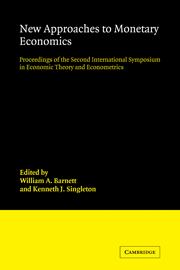 New Approaches to Monetary Economics
New Approaches to Monetary Economics Published online by Cambridge University Press: 04 August 2010
Introduction
A general equilibrium model of an economy is presented where people hold money rather than bonds in order to economize on transaction costs. It is not optimal for individuals to instantaneously adjust their money holdings when new information arrives. This (endogenous) delayed response to new information generates a response to a new monetary policy which is quite different from that of standard flexible price models of monetary equilibrium. Though all goods markets instantaneously clear, the transaction cost causes delayed responses in nominal variables to a change in monetary policy. This in turn causes real variables to respond to the new monetary policy.
Earlier work by Grossman and Weiss (1983), Grossman (1982), and Rotemberg (1984) have considered models of the above type where individuals hold money for an exogenously fixed amount of time – their “payment period.” As in the model to be developed here, these models assume that goods can be bought only with cash. However, unlike what we will assume here, individuals can exchange bonds for cash only on the exogenously fixed “paydates” which occur at the beginning and end of their payment periods. Thus an individual's money holding period is exogenously given and insensitive to the nominal interest rate. In such models, when there is an unanticipated increase in the money supply, people can be induced to hold the new money only by a large fall in the real rate of interest.
To save this book to your Kindle, first ensure [email protected] is added to your Approved Personal Document E-mail List under your Personal Document Settings on the Manage Your Content and Devices page of your Amazon account. Then enter the ‘name’ part of your Kindle email address below. Find out more about saving to your Kindle.
Note you can select to save to either the @free.kindle.com or @kindle.com variations. ‘@free.kindle.com’ emails are free but can only be saved to your device when it is connected to wi-fi. ‘@kindle.com’ emails can be delivered even when you are not connected to wi-fi, but note that service fees apply.
Find out more about the Kindle Personal Document Service.
To save content items to your account, please confirm that you agree to abide by our usage policies. If this is the first time you use this feature, you will be asked to authorise Cambridge Core to connect with your account. Find out more about saving content to Dropbox.
To save content items to your account, please confirm that you agree to abide by our usage policies. If this is the first time you use this feature, you will be asked to authorise Cambridge Core to connect with your account. Find out more about saving content to Google Drive.